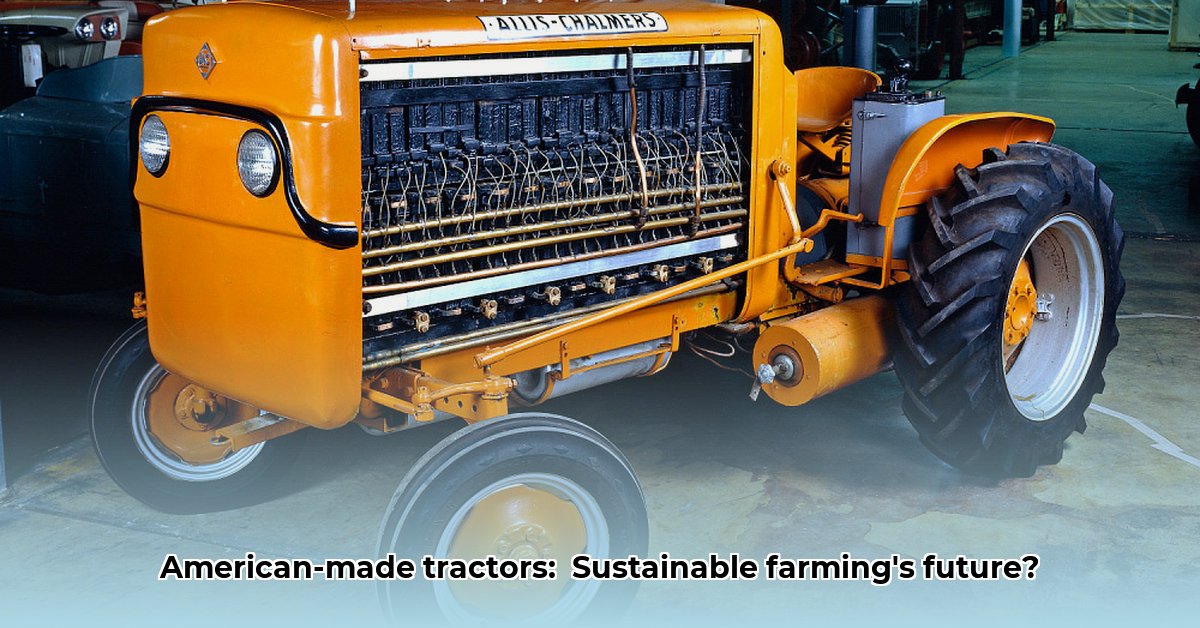
Choosing the right tractor is a pivotal decision for any farmer, impacting not only productivity and profits but also environmental sustainability. This guide navigates the complexities of "Made in the USA" tractors, focusing on responsible and sustainable agricultural practices. We'll examine the true meaning of "Made in the USA" in tractor manufacturing, analyze environmental impacts, and provide actionable steps for informed purchasing decisions. For more in-depth guidance, check out this helpful resource: tractor buying guide.
The Reality of "Made in the USA" Tractors
The term "American-made tractor" often misleads. While many brands have significant U.S. manufacturing, global supply chains mean that parts originate worldwide. For example, John Deere, a prominent player, boasts substantial U.S. manufacturing, but its tractors are far from 100% domestically sourced. The precise percentage of American-made components varies significantly among brands and models. This lack of transparency hinders informed choices for farmers seeking to support both the domestic economy and environmental sustainability. Greater transparency from manufacturers concerning the origin of parts is crucial. How much of a tractor's value is truly "Made in the USA"? This crucial piece of information is often unavailable.
Sustainability Considerations: Beyond Fuel Efficiency
Sustainable farming extends beyond fuel-efficient engines. It encompasses the entire lifecycle of a tractor, from raw material sourcing to manufacturing processes and eventual disposal. Key factors include:
- Emissions: Lower emissions translate to cleaner air and a smaller carbon footprint; a crucial consideration for environmentally conscious farming.
- Lifespan: A longer-lasting tractor reduces the frequency of replacements, minimizing waste and environmental impact.
- Manufacturing Impact: The environmental effects of a tractor’s production should be considered. Transparent lifecycle assessments from manufacturers are needed to provide a clear picture to farmers.
Currently, comprehensive data comparing the environmental impact of different models is lacking. Manufacturers must provide transparent lifecycle assessments to empower informed decision-making. What are the true environmental costs of manufacturing a specific tractor model? This information is critical for sustainable agricultural practices.
Tractors for Different Farming Scales
Tractor selection depends heavily on farm size and operational needs. Small-scale farms benefit from compact, maneuverable tractors suitable for precise work in smaller areas. Large-scale operations, however, require larger, more powerful machines capable of handling extensive acreage. Oversizing a tractor for a small farm is inefficient, wasting fuel and potentially causing environmental damage. Selecting a right-sized tractor minimizes fuel consumption, reduces soil compaction, and optimizes resource use. What's the sweet spot in tractor size for your farm operations? This hinges on acreage, type of crops, and specific agricultural needs.
Actionable Advice for Farmers & Consumers
Choosing a sustainable, American-made tractor requires a systematic approach:
- Define Needs: Clearly identify your tractor's tasks, influencing size, horsepower, and essential features.
- Fuel Efficiency Research: Compare fuel consumption across models, based on expected tasks. Lower fuel consumption translates to lower costs and minimized environmental impact.
- Lifecycle Cost Analysis: Don't just focus on the purchase price. Consider fuel, maintenance, repairs, and potential resale value. A seemingly cheaper tractor may end up costing more in the long run.
- Demand Transparency: Choose manufacturers openly disclosing their supply chain and environmental impact data. Avoid vague claims.
- Responsible Disposal Planning: Explore recycling or responsible disposal options at the end of the tractor's life. Sustainable disposal is an integral element of environmentally conscious farming.
Following these steps equips farmers with the tools to make responsible and sustainable decisions. How can you maximize the lifespan of your tractor while minimizing environmental impact? These guidelines point to a solution.
Policy Recommendations: Government's Role
Government policies play a crucial role in fostering sustainable tractor manufacturing and farming. Incentives for fuel-efficient tractors and clear labeling standards promoting transparency are essential. Regulations enforcing sustainable manufacturing processes and emissions standards could further encourage innovation and environmental responsibility. Effective government policies are indispensable for advancing sustainable agriculture. What policy changes could boost the adoption of sustainable practices in the agricultural sector? This question requires careful consideration by policymakers.
Conclusion: A Collective Effort
Building a sustainable agricultural future requires collaboration between farmers, manufacturers, and policymakers. Transparency, data-driven decision-making, and shared commitment to sustainable practices are vital. The pursuit of truly sustainable American-made tractors benefits from collective action and commitment to environmentally responsible practices. How can we collectively work towards a more sustainable agricultural system? This is a call to action for all stakeholders.